Pernio/Chillblains
Swelling may occur, and they can leave the skin prone to cracking and infection. Commonly affecting the toes but also extending to the fingers and areas of pressure on the feet, such as bunions or tight shoe areas, chilblains can significantly impact one's comfort and well-being.
If you're experiencing symptoms of pernio or chilblains, seek expert dermatological care at Rencic Dermatology to receive personalized treatment and relief.
Examples of Pernio/Chillblains
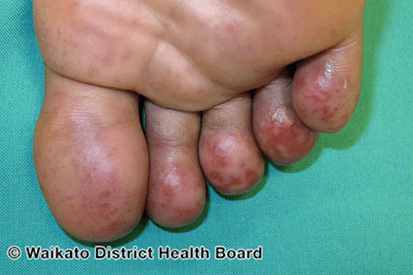
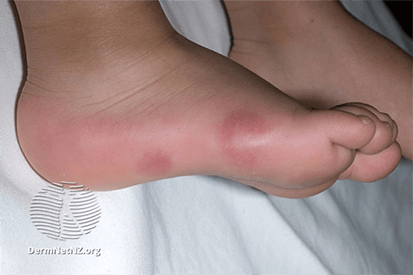
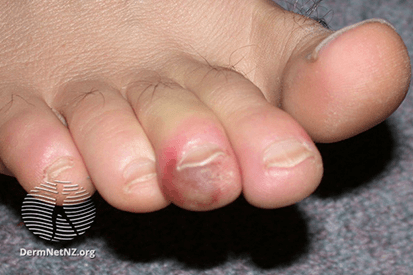
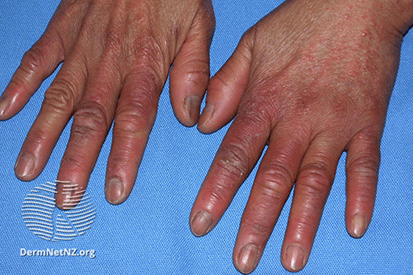
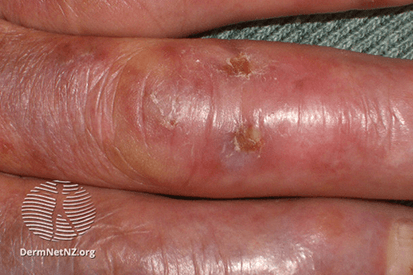
What are the Symptoms of Pernio/Chillblains?
- Burning and itching in the affected area, particularly during cold weather.
- Intensification of symptoms upon exposure to warmth.
- Swelling and redness in the affected area.
- Formation of sores (ulcers) as the skin over the chilblain breaks down.
- Potential for infection within the chilblain, leading to complications.
Causes of Pernio/Chillblains
- Cold weather exposure: Pernio typically occurs during colder months when temperatures drop, especially in individuals with poor cold tolerance.
- Poor circulation: Reduced blood flow to the extremities, often due to factors like genetics, cardiovascular conditions, or lifestyle habits, can increase susceptibility to chilblains.
- Familial tendency: Some individuals may have a genetic predisposition to developing chilblains.
- Hormonal factors: Chilblains are more common in females, suggesting a potential hormonal influence on their development.
- Lifestyle factors: Smoking and poor nutrition can contribute to vascular issues and increase the risk of chilblains.
- Damp living conditions: Exposure to dampness and moisture can exacerbate chilblain symptoms, especially when combined with cold temperatures.
Pernio/Chillblains Prevention
Consider using foot warmers or other insulating accessories for added protection when outdoors. Upon returning indoors, gradually rewarm your feet to avoid worsening symptoms, steering clear of rapid rewarming in front of heaters or fireplaces. Additionally, minimize sudden temperature changes to lower the risk of developing chilblains.
For proactive medical intervention, consider taking a daily low-dose aspirin (81 mg) to enhance circulation and reduce chilblain susceptibility.
By actively implementing these preventive measures and seeking appropriate medical guidance, you can effectively reduce the likelihood of chilblains and maintain optimal foot health in colder weather.
Pernio/Chillblains FAQs
While chilblains commonly occur on the toes and fingers, they can also affect other areas of the body, particularly those exposed to pressure or tight clothing, such as the ears, nose, and areas with bunions or tight shoes.
Keeping the affected areas clean and moisturized can help soothe chilblains. Using gentle cleansers and fragrance-free moisturizers can prevent dryness and cracking, reducing the risk of infection. Additionally, prescription steroid creams may be recommended by dermatologists to alleviate inflammation and itching.
Chilblains can sometimes be mistaken for conditions like frostbite, dermatitis, or allergic reactions. Dermatologists can differentiate chilblains by examining the characteristic symptoms, such as small, itchy, red areas that become painful and dark blue. Diagnostic tests may also be conducted if necessary.
Lifestyle modifications such as wearing warm, protective clothing, avoiding sudden temperature changes, and quitting smoking can help prevent chilblains from recurring. Additionally, maintaining a healthy weight and improving circulation through regular exercise may reduce the risk of developing chilblains.
Yes, certain medical conditions such as Raynaud's phenomenon, lupus, and autoimmune disorders can increase the susceptibility to chilblains. Individuals with poor circulation, anemia, or connective tissue disorders may also be at higher risk. Consulting with a dermatologist can help identify and address any underlying conditions contributing to chilblains.
Pernio/Chillblains Treatment Options
Topical treatments, such as prescription steroid creams or ointments, can be applied to reduce inflammation and itching, aiding in the healing process. Over-the-counter pain relievers like ibuprofen or acetaminophen may be used to manage any associated pain. Additionally, minimizing exposure to cold and damp conditions, as well as avoiding sudden temperature changes, helps prevent symptom exacerbation and the development of new chilblains. Medical evaluation is essential to address any underlying conditions contributing to chilblains, such as circulatory disorders or autoimmune diseases.
Furthermore, practicing gradual rewarming techniques after cold exposure and keeping the skin well-moisturized are beneficial. Lifestyle modifications, including quitting smoking, improving nutrition, and maintaining a healthy weight, can also enhance overall circulation and reduce the likelihood of chilblains. Consulting with a healthcare provider is crucial for personalized treatment recommendations based on individual symptoms and medical history, ensuring effective management and prevention of complications associated with chilblains.
Featured Products
Check your local office for current stock!
Check your local office for current stock!
